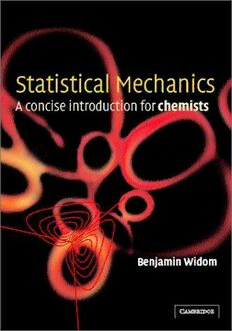
Statistical mechanics: a concise introduction for chemists PDF
Preview Statistical mechanics: a concise introduction for chemists
P1:GBY/GIO P2:FGU/FEO QC:FLC/GBY T1:GIO 0521811198PRE CU190-Widom January22,2002 12:32 CharCount=0 StatisticalMechanics AConciseIntroductionforChemists Statistical mechanics is the theoretical apparatus used to study the properties ofmacroscopicsystems–systemsmadeupofmanyatomsormolecules–and relatesthosepropertiestothesystems’microscopicconstitution.Thisbookis anintroductiontostatisticalmechanics,intendedtobeusedeitherbyadvanced undergraduatesorbybeginninggraduatestudents. The first chapter deals with statistical thermodynamics and aims to derive quicklythemostcommonlyusedformulasinthesubject.Thebulkofthebook thenillustratesthetraditionalapplicationsoftheseformulas,suchastheideal gas,chemicalequilibriumconstantsfrompartitionfunctions,theidealharmonic solid,andthestatisticalmechanicalbasisofthethirdlawofthermodynamics. Thelastfewchaptersdealwithlesstraditionalmaterialsuchasthenon-ideal gasandthequantumidealgases. BENJAMINWIDOMisGoldwinSmithProfessorofChemistryatCornellUniver- sity.HereceivedhisPh.D.inphysicalchemistryfromthatuniversity(wherehe studiedwithS.H.Bauer)in1953,andwasapostdoctoralassociatewithO.K. RiceattheUniversityofNorthCarolina,beforejoiningtheCornellchemistry facultyin1954. Hisresearchspecialtyisstatisticalmechanicsandthermodynamics,particu- larlyasappliedtoproblemsofphaseequilibria,criticalphenomena,andinter- facialstructureandthermodynamics.Heisco-authorwithProfessorSirJohn Rowlinson,ofOxfordUniversity,oftheresearchmonographMolecularTheory ofCapillarity(1982). Hehasheldnumerousprestigiousvisitorships,includingonesatAmsterdam (van der Waals Professor), Oxford (IBM Visiting Professor of Theoretical Chemistry), Leiden (Lorentz Professor), and Utrecht (Kramers/Debye Pro- fessor). He has had many awards in recognition of his research in statistical mechanics,includingtheBoltzmannMedaloftheIUPAPCommissiononStat- istical Physics and the Onsager Medal of the University of Trondheim. He has honorary degrees from the University of Chicago and the University of Utrecht,andhasbeenelectedtomembershiporfellowshipofseveralscholarly academiesincludingtheU.S.NationalAcademyofSciencesandtheAmerican PhilosophicalSociety. i P1:GBY/GIO P2:FGU/FEO QC:FLC/GBY T1:GIO 0521811198PRE CU190-Widom January22,2002 12:32 CharCount=0 ii P1:GBY/GIO P2:FGU/FEO QC:FLC/GBY T1:GIO 0521811198PRE CU190-Widom January22,2002 12:32 CharCount=0 Statistical Mechanics A Concise Introduction for Chemists B.Widom CornellUniversity iii Cambridge, New York, Melbourne, Madrid, Cape Town, Singapore, São Paulo Cambridge University Press The Edinburgh Building, Cambridge , United Kingdom Published in the United States of America by Cambridge University Press, New York www.cambridge.org Information on this title: www.cambridge.org/9780521811194 © Benjamin Widom 2002 This book is in copyright. Subject to statutory exception and to the provision of relevant collective licensing agreements, no reproduction of any part may take place without the written permission of Cambridge University Press. First published in print format 2002 - ---- eBook (NetLibrary) - --- eBook (NetLibrary) - ---- hardback - --- hardback - ---- paperback - --- paperback Cambridge University Press has no responsibility for the persistence or accuracy of s for external or third-party internet websites referred to in this book, and does not guarantee that any content on such websites is, or will remain, accurate or appropriate. P1:GBY/GIO P2:FGU/FEO QC:FLC/GBY T1:GIO 0521811198PRE CU190-Widom January22,2002 12:32 CharCount=0 Contents Preface page vii 1 TheBoltzmanndistributionlawandstatistical thermodynamics 1 1.1 Nature and aims of statistical mechanics 1 1.2 TheBoltzmanndistributionlaw 2 1.3 Thepartitionfunctionandstatisticalthermodynamics 6 2 The ideal gas 16 2.1 Boltzmannstatistics 16 2.2 Translational partition function 21 2.3 Vibrational partition function 27 2.4 Rotational partition function; ortho- and para-hydrogen 31 2.5 The “law” of the equipartition of energies 41 2.6 Partitionfunctionwithexcitedelectronicstates 43 3 Chemicalequilibriuminideal-gasmixtures 47 3.1 Thermodynamicpreliminaries;theequilibriumconstant 47 3.2 Equilibriumconstantsfrompartitionfunctions 49 4 Idealharmonicsolidandblack-bodyradiation 55 4.1 Idealharmoniccrystal 55 4.2 Rayleigh–Jeanslaw 57 4.3 Debyetheoryoftheheatcapacityofsolids 62 4.4 Black-body radiation 66 5 Thethirdlaw 69 5.1 Nernst heat theorem in thermodynamics 69 5.2 Thirdlawinstatisticalmechanics 71 5.3 Comparisonwithexperiment 75 6 Thenon-idealgas 81 6.1 Virialcoefficients 81 6.2 Intermolecularforces 83 6.3 Secondvirialcoefficientfromstatisticalmechanics 87 6.4 Long-rangeforces 98 v P1:GBY/GIO P2:FGU/FEO QC:FLC/GBY T1:GIO 0521811198PRE CU190-Widom January22,2002 12:32 CharCount=0 vi Contents 7 The liquid state 101 7.1 Structure of liquids 101 7.2 Equation of state of a liquid 106 7.3 Computer simulation: molecular dynamics 114 7.4 Computersimulation:MonteCarlo 127 8 Quantum ideal gases 133 8.1 Bose–EinsteinandFermi–Diracstatisticsversus Boltzmann statistics 133 8.2 The grand-canonical partition function 138 8.3 Grand partition function of the quantum ideal gases 143 8.4 The ideal gas in Fermi–Dirac statistics 155 8.5 The ideal gas in Bose–Einstein statistics 162 Index 169 P1:GBY/GIO P2:FGU/FEO QC:FLC/GBY T1:GIO 0521811198PRE CU190-Widom January22,2002 12:32 CharCount=0 Preface This is an introduction to statistical mechanics, intended to be used either in anundergraduatephysicalchemistrycourseorbybeginninggraduatestudents withlittleundergraduatebackgroundinthesubject.Itassumesfamiliaritywith thermodynamics,chemicalkineticsandthekinetictheoryofgases,andquantum mechanicsandspectroscopy,atthelevelatwhichthesesubjectsarenormally treated in undergraduate physical chemistry. Ideas, principles, and formulas fromthemareappealedtofrequentlyinthepresentwork. Ifstatisticalmechanicsconstitutedabout10%ofaphysicalchemistrycourse itwouldbecoveredin8to12lectures,dependingonwhetherthecourseasa wholeweretaughtintwosemestersorthree.Thereisenoughmaterialinthese chaptersfor12lectures(ormore).Theinstructorwhohasonly8availablewill havetobeselective.Themosttechnicalparts,andsothelikeliestcandidatesfor omissionorcontraction,arethetreatmentofortho-andpara-hydrogen,which is part of §2.4 of Chapter 2, that of molecular dynamics and Monte Carlo computer simulations in Chapter 7 (§§7.3 and 7.4), and that of the quantum ideal gases in Chapter 8, which includes a discussion of the grand partition function(§8.2). Because only a relatively short time may be devoted to the subject it is important to arrive quickly at the usable formulas and important applications while still keeping the level consistent with that of an undergraduate physi- calchemistrycourse.ThestrategyadoptedhereistostartwiththeBoltzmann distributionlaw,makingitplausiblebyappealtotwoofitsspecialcases(the Maxwellvelocitydistribution,assumedtobeknownfromanearliertreatment ofelementarykinetictheory,andthebarometricdistribution,whichisderived, or re-derived, here), and by observing that its exponential form is required bythecompositionofprobabilitiesforindependentsystems.Thedistribution lawisstatedwithdiscrete-state,quantummechanicalenergy-levelnotationat vii P1:GBY/GIO P2:FGU/FEO QC:FLC/GBY T1:GIO 0521811198PRE CU190-Widom January22,2002 12:32 CharCount=0 viii Preface an early stage so as not to require generalizing the theory later from classi- caltoquantummechanicallanguage.Inafull-scale,graduate-levelstatistical mechanicscourse,whereonehastheleisuretodevotemoretimetothefoun- dations and where the students have more background in physics and math- ematics, one can make a good case for starting with a classical phase-space formulationandlatergeneralizingittothequantummechanicalversion.One would then typically start with the microcanonical rather than the canonical distribution. OncetheBoltzmanndistributionlawisstatedthepartitionfunctionappears naturallyasanormalizationdenominator.Themachineryofstatisticalthermo- dynamics – the connection of the free energy to the partition function – then followsfromcomparingthemeanenergyimpliedbythedistributionlawwith that obtained from the free energy by the Gibbs–Helmholtz equation of ther- modynamics.(Amongearliertreatmentsofthesubject,thatinGuggenheim’s wonderfullittlebookBoltzmann’sDistributionLawisprobablythattowhich thisoneisclosestinspirit.)Thisisfollowedbyaqualitativediscussionofen- ergyfluctuationsinasystemoffixedtemperature,andthentheconnectionis madetoamicrocanonicalsystemandthefamousS =klnW. What has just been outlined is the content of the first chapter, in which the machinery is set up. The next four chapters are devoted to the traditional applications:thestatisticalthermodynamicsoftheidealgasofmoleculeswith internal structure (Chapter 2), chemical equilibrium constants from partition functions(Chapter3),theidealharmonicsolid(Chapter4),andthestatistical mechanicalbasisofthethirdlawofthermodynamics(Chapter5). Much of the material in the remaining three chapters is less traditional in an undergraduate physical chemistry course but would be suitable even there and certainly at the beginning graduate level. The non-ideal gas (Chapter 6) provides the first glimpse of the problem of non-separable degrees of free- dom, which appears in its undiluted and most challenging form in the liquid state (Chapter 7). The concluding chapter, on the quantum ideal gases, in- cludesthedegenerateelectrongasasamodelforelectronsinmetals,asubject that most instructors would wish to say something about even if they should choose to omit much of the detail in that section and much of the rest of the chapter. Only equilibrium statistical mechanics is presented here. There are many topics in non-equilibrium statistical mechanics (the Nernst–Einstein relation betweendiffusioncoefficientandmobilitybeinganexample)thatareofinterest andimportanceinphysicalchemistry,butgivenonly8–12lecturessomeheart- breakingchoiceshavetobemade,aseveryinstructorknows. P1:GBY/GIO P2:FGU/FEO QC:FLC/GBY T1:GIO 0521811198PRE CU190-Widom January22,2002 12:32 CharCount=0 Preface ix I wish to express my appreciation to Professors Roger Loring (Cornell), IgalSzleifer(Purdue),andDevarajanThirumalai(Maryland)fortheiradvice and encouragement, and to Ms Kelly Case for her expert assistance with the preparationofthemanuscript. B.Widom CornellUniversity
